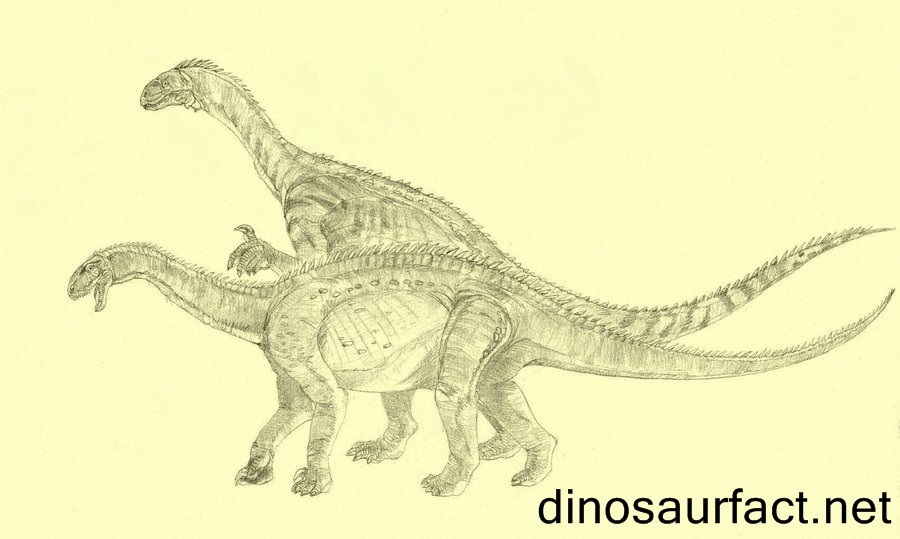[Recent Entries][Archive][Friends][User Info]
March 12th, 2012
| March 12th, 2012 | |
|---|---|
| 05:21 pm [industrialterro] [Link] |
Alwalkeria Alwalkeria ( This dinosaur was originally named Walkeria maleriensis by Sankar Chatterjee in 1987, in honor of famous British paleontologist Alick Walker and the Maleri Formation, in which its fossils were found. However, the original generic name was found to be preoccupied by a bryozoan. A new name was created in 1994 by Chatterjee and Ben Creisler. Remains of Alwalkeria have been recovered from the Maleri Formation of Andhra Pradesh, India. This is a Late Triassic geologic formation. Indeterminate prosauropod material has also been found in the Maleri, but Alwalkeria is the only named dinosaur species. The one known specimen is partial and consists of parts of the front ends of the upper and lower jaws, 28 incomplete vertebrae from all parts of the spinal column, most of a femur (thigh bone), and an astragalus (ankle bone). The partial skull is about 4 centimeters long (1.5 in). Although material of Alwalkeria is limited, the spacing and shape of the teeth strongly resemble those of Eoraptor. As in Eoraptor, a gap separates the teeth of the premaxillary and the maxillary bones of the upper jaw. Other similarities in the skull of the two animals also link them on morphologic grounds (Langer 2004). Alwalkeria has not been included in a cladistic analysis, but its similarities to Eoraptor suggest it may have held a similar position in the dinosaur family tree. However, the position of Eoraptor is disputed. One recent analysis finds it within the order Saurischia, but basal to the Theropoda-Sauropodomorpha split (Langer 2004). Paul Sereno finds instead that Eoraptor is a basal theropod (Sereno 1999). Others place Eoraptor outside of Dinosauria completely (Fraser et al. 2002). This dinosaur also has a heterodont dentition in the upper jaw, meaning that the teeth are differently shaped depending on their position within the jaw. Similarly to Eoraptor and basal sauropodomorphs, the front teeth are slender and straight, while the teeth in the sides of the jaw are curved backwards like those of predatory theropods, although none are serrated. This arrangement of teeth is neither clearly herbviorous nor clearly carnivorous, which suggests that this dinosaur was an omnivore with a varied diet, including insects, small vertebrates, and plant material. Several features make Alwalkeria unique among basal dinosaurs. Besides its unserrated teeth, and the mandibular symphysis is proportionally wider than almost any other known dinosaur. Also, there is a very large articulation between the fibula and the ankle.
Tags: Вымершие рептилии, Триас, авеметатарзалии, архозавроморфы, архозавры, диапсиды, динозавроморфы, динозавры, ящеротазовые |
| Time | Event |
| 05:36 pm [industrialterro] [Link] |
Antetonitrus Antetonitrus (pronounced ant-EE-tohn-IET-rus; meaning "before the thunder") is the oldest known genus of sauropod dinosaur, living during the Late Triassic Period of southern Africa. It was a quadrupedal herbivore, like many of its later relatives, although it was far smaller than some of them. Antetonitrus was the largest animal in its environment, reaching up to 33 feet (10 m) long and weighing up to two tons, but still shows some primitive adaptations to use the forelimbs for grasping, instead of purely for weight support. The fossils now known as Antetonitrus were actually discovered by Kitching in 1981 in the Free State of South Africa, and were stored in the Bernard Price Institute where they were labeled as Euskelosaurus. Yates recognized them as a separate taxon and published a description several years later. The holotype, or original specimen, consists of several vertebrae and numerous bones from both forelimb and hind limb, all presumed to be from one individual. Five more limb bones from another smaller individual were also referred to the genus. Antetonitrus shows several features which appear to be approaching those of sauropods, but still retains some primitive features. Unlike most of its smaller and more lightly built ancestors, Antetonitrus was primarily quadrupedal. Like sauropods, its forelimbs were much longer relative to its hind legs than earlier animals, and the wrist bones were broader and thicker to support more weight. However, the first digit of the hand, also called the "thumb" or pollex, was still twisted and flexible, capable of grasping against the hand. In more derived sauropods, the wrist bones are large and thick, arranged in such a way as to lock the hand into a permanently pronated position for full-time weight support, and the hand is incapable of grasping. A cladistic analysis recognizes Antetonitrus as a basal sauropod, occupying a position between more derived animals such as Isanosaurus or Vulcanodon, and more basal sauropods like Melanorosaurus. The back vertebrae are extremely similar to Lessemsaurus from South America, while the limb bones are similar to Blikanasaurus, another stocky early sauropod from South Africa. However, these animals were not included in a cladistic analysis with Antetonitrus because they are poorly known (Yates & Kitching, 2003). While Antetonitrus is not the earliest sauropod from a phylogenetic standpoint, it currently the oldest known sauropod chronologically, or rather tied for that distinction with other early sauropods from the same formation, like Melanorosaurus and Blikanasaurus. Fossils of these animals were recovered from the Lower Elliot Formation, which dates to the Norian stage of the Late Triassic, or approximately 221 to 210 million years ago. Before Antetonitrus and the other Lower Elliot animals were recognized as sauropods, the oldest known sauropod had been Isanosaurus from the Rhaetian stage, a slightly younger segment of the Triassic, of Thailand (Buffetaut et al., 2000). Early sauropods and their prosauropod relatives were found around the world as all of the continents were at the time united into the single supercontinent, Pangaea, which made dispersal across the entire terrestrial world possible.
Tags: Вымершие рептилии, Триас, авеметатарзалии, архозавроморфы, архозавры, диапсиды, динозавроморфы, динозавры, завроподоморфы, завроподы, ящеротазовые |
| Previous Day | 2012/03/12 [Archive] |
Next Day |






